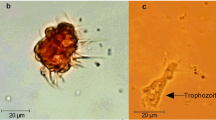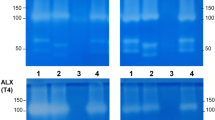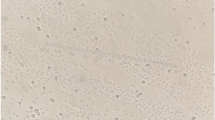Abstract
Members of the genus Acanthamoeba are of the most common protozoa that has been isolated from a variety of environment and affect immunocompromised individuals, causing granulomatous amoebic encephalitis and skin lesions. Acanthamoeba, in immunocompetent patients, may cause a keratitis related to corneal microtrauma. These free-living amoebas easily adapt to the host environment and wield metabolic pathways such as the energetic and respiratory ones in order to maintain viability for long periods. The energetic metabolism of cysts and trophozoites remains mostly unknown. There are a few reports on the energetic metabolism of these organisms as they are mitochondriate eukaryotes and some studies under aerobic conditions showing that Acanthamoeba hydrolyzes glucose into pyruvate via glycolysis. The aim of this study was to detect the energetic metabolic pathways with emphasis on anaerobic metabolism in trophozoites of three isolates of Acanthamoeba sp belonging to the T4 genotype. Two samples were collected in the environment and one was a clinical sample. The evaluation of these microorganisms proceeded as follows: rupture of trophozoites (7.5 × 103 parasites/ml) and biochemical analysis with high performance liquid chromatography and spectrophotometry. The anaerobic glycolysis was identified through the detection of glucose, pyruvate, and lactate. The protein catabolism was identified through the detection of fumarate, urea, and creatinine. The fatty acid oxidation was identified through the detection of acetate, beta-hydroxybutyrate, and propionate. The detected substances are the result of the consumption of energy reserves such as glycogen and lipids. The anaerobic glycolysis and protein catabolism pathways were observed in all three isolates: one clinical and two environmental. This study represents the first report of energetic pathways used by trophozoites from different isolates of the T4 genotype Acanthamoeba.

Similar content being viewed by others
References
Alves DSMM, Moraes AS, Nitz N, Oliveira MGC, Hecht MM, Gurgel-Gonçalves R, Cuba-Cuba AC (2012) Occurrence and characterization of Acanthamoeba similar to genotypes T4, T5 and T2/T6 isolated from environmental sources in Brasília, Federal District, Brazil. Exp Parasitol 131:239–244. doi:10.1016/j.exppara.2012.04.011
Alves DSMM, Moraes AS, Gurgel-Gonçalves R, Alves LM, Lino Junior RS, Cuba CAC, Vinaud MC (2016) Experimental infection of T4 Acanthamoeba genotype determines the pathogenic potential. Parasitol Res 1–6. doi:10.1007/s00436-016-5105-3
Aqeel Y, Siddiqui R, Farooq M, Khan NA (2015) Anaerobic respiration: in vitro efficacy of Nitazoxanide against mitochondriate Acanthamoeba castellanii of the T4 genotype. Exp Parasitol 157:170–176. doi:10.1016/j.exppara.2015.08.007
Band RN, Mohrlok S (1969) The respiratory metabolism of Acanthamoeba rhysodes during encystation. J Gen Microbiol 59:351–358
Bowers B, Korn ED (1968) The fine structure of Acanthamoeba castellanii (Neff strain). I. The trophozoite. J Cell Biol 39:95–111
Bowers B, Korn ED (1969) The fine structure of Acanthamoeba castellanii (Neff strain). II. Encystment. J Cell Biol 41:786–805
Bowers B, Korn ED (1974) Localization of lipophosphonoglycan on both sides of Acanthamoeba plasma membrane. J Cell Biol 62:533–540
Champe PC, Harvey RA, Ferrier DR (2009) Bioquímica ilustrada, 4th edn. Artmed, Porto Alegre
Clarke DW, Niederkorn JY (2006) The pathophysiology of Acanthamoeba keratitis. Trends Parasitol 22(4):175–180. doi:10.1016/j.pt.2006.02.004
Coombs GH, Mottram JC (1997) Parasite proteinases and amino acid metabolism: possibilities for chemotherapeutic exploitation. Parasitology 11(7):61–80
Ctrnacta V, Ault JG, Stejskal F, Keithly JS (2006) Localization of pyruvate: NADP oxidoreductase in sporozoites of Cryptosporidium parvum. J Eukaryot Microbiol 53:225–231. doi:10.1111/j.1550-7408.2006.00099.x
Fritz-Laylin LK, Prochnik SE, Ginger ML et al (2010) The genome of Naegleria gruberi illuminates early eukaryotic versatility. Cell 140:631–642. doi:10.1016/j.cell.2010.01.032
Ginger ML, Fritz-Laylin LK, Fulton C, Cande WZ, Dawson SC (2010) Intermediary metabolism in protists: a sequence-based view of facultative anaerobic metabolism in evolutionarily diverse eukaryotes. Protist 161:642–671. doi:10.1016/j.protis.2010.09.001
Hug LA, Stechmann A, Roger AJ (2010) Phylogenetic distributions and histories of proteins involved in anaerobic pyruvate metabolism in eukaryotes. Mol Biol Evol 27:311–324. doi:10.1093/molbev/msp237
Khan NA (2006) Acanthamoeba: biology and increasing importance in human health. FEMS Microbiol Rev 30(4):564–595. doi:10.1111/j.1574-6976.2006.00023.x
Khan NA, Jarroll EL, Paget TA (2002) Molecular and physiological differentiation between pathogenic and nonpathogenic Acanthamoeba. Curr Microbiol 45(3):197–202
Leger MM, Gawryluk RMR, Gray MW, Roger AJ (2013) Evidence for a hydrogenosomal-type anaerobic ATP generation pathway in Acanthamoeba castellanii. PLoS One 8(9):69532. doi:10.1371/journal.pone.0069532
Lemgruber L, Lupetti P, Souza WD, Vommaro RC, Rocha-Azevedo B (2010) The fine structure of the Acanthamoeba polyphaga cyst wall. FEMS Microbiol Lett 305:170–176. doi:10.1111/j.1574-6968.2010.01925.x
Lorenzo-Morales J, Kliescikova J, Martinez-Carretero E, De Pablos LM, Profotova B, Nohynkova E, Osuna A, Valladares B (2008) Glycogen phosphorylase in Acanthamoeba spp.: determining the role of the enzyme during the encystment process using RNA interference. Eukariotic Cell 509–517. doi:10.1128/EC.00316-07
Martinez AJ, Visvesvara GS (1997) Free-living, amphizoic and opportunistic amebas. Brain Pathol 7(1):583–598
Ortega-Rivas A, Padrón JM, Valladares B, Elsheikha HM (2016) Acanthamoeba castellanii: a new high-throughput method for drug screening in vitro. Acta Trop 164(2016):95–99
Poulin R, Larochelle J, Hellebust JA (1987) The regulation of amino acid metabolism during hyperosmotic stress in Acanthamoeba castellanii. Comp Biochem Physiol 243(3):265–378. doi:10.1002/jez.1402430303
Prescott LM, Hoyme HE, Crockett D, Hui E (1973) Carbohydrate metabolism in Acanthamoeba castellanii 1. The activity of key enzymes and [14C]-glucose metabolism. Can J Microbiol 9:1131–1136. doi:10.1139/m73-180
Pussard M, Pons R (1977) Morphologie de la paroi kystique et taxonomie du genre Acanthamoeba (Protozoa, Amoebida). Protistology 13:557–598
Scheid P (2014) Relevance of free-living amoebae as hosts for phylogenetically diverse microorganisms. Parasitol Res 113:2407–2414. doi:10.1007/s00436-014-3932-7
Serrano-Suárez A, Dellundé J, Salvadó H, Cervero-Aragó S, Méndez J, Canals O, Blanco S, Arcas A, Araujo R (2013) Microbial and physicochemical parameters associated with Legionella contamination in hot water recirculation systems. Environ Sci Pollut Res 20:5534–5544. doi:10.1007/s11356-013-1557-5
Siddiqui R, Emes R, Elsheikha H, Khan NA (2011) Area 51: how do Acanthamoeba invade the central nervous system? Trends Parasitol 27(5):185–189. doi:10.1016/j.pt.2011.01.005
Schuster FL, Visvesvara GS (2004) Free-living amoebae as opportunistic and non-opportunistic pathogens of humans and animals. Int J Parasitol 34(9):1001–1027. doi:10.1016/j.pt.2011.01.005
Tawfeek GM, Bishara SAH, Sarhan RM, Taher EE, Khayyal AE (2016) Genotypic, physiological, and biochemical characterization of potentially pathogenic Acanthamoeba isolated from the environment in Cairo, Egypt. Parasitol Res. doi:10.1007/s00436-016-4927-3
Tomlinson G (1967) The glyoxylate pathway in Acanthamoeba sp. J Euk Microbiol 14(1):114–116. doi:10.1111/j.1550-7408.1967.tb01456.x
Vinaud MC, Lino Junior RS, Bezerra JCB (2007) Taenia crassiceps organic acids detected in cysticerci. Exp Parasitol 116:335–339. doi:10.1016/j.exppara.2007.01.013
Acknowledgements
The authors would like to thank CNPQ for the financial support, Grant Number 471009/2013-0 to Dr. Marina Clare Vinaud.
Author information
Authors and Affiliations
Corresponding author
Ethics declarations
Conflict of interest
The authors declare that they have no conflict of interest.
Rights and permissions
About this article
Cite this article
Alves, D.d.S.M.M., Alves, L.M., da Costa, T.L. et al. Anaerobic Metabolism in T4 Acanthamoeba Genotype. Curr Microbiol 74, 685–690 (2017). https://doi.org/10.1007/s00284-017-1223-0
Received:
Accepted:
Published:
Issue Date:
DOI: https://doi.org/10.1007/s00284-017-1223-0




